LPG more than a match for petrol
BY PHILIP LORD | 2nd Mar 2010

The Orbital-enhanced dual-fuel Falcon, which boasts the same power and performance on LPG as the standard petrol XR6, was made available during a drive day of LPG vehicles coinciding with the LPG Industry Report Card 2010 in Canberra last week The latest LPG models from Holden, Impco and Alternative Fuel Innovations (AFI)were also among the LPG vehicles at the drive day.
The main driver for the innovations in the LPG industry is to a large degree the Euro 4 emission compliance requirements for LPG vehicles on July 1 this year. The old fumigator style LPG systems will not pass the new emissions requirements, while the sequential injection type (either vapour or liquid) are capable of meeting the Euro 4 limits.
Orbital bought Boral Alternative Fuel Systems – which held the Ford contract for supply of LPG technology for the E-Gas Falcon – two years ago, and continues to develop new technology for both its own retail customers and for Ford.
Orbital has tied up some of the world’s best LPG intellectual property under agreements with international companies Vialle, of the Netherlands, and Continental, of Germany. Siemens supplies the Italian-made injectors for the Falcon conversion.

.Orbital’s Falcon XR6 retrofit Liquid LPG Injection (LLI) kit that LPG fitters sell for around $4500 fitted is a port injection system that injects LPG as a liquid via one injector per cylinder. Peak output remains 195kW on LPG or petrol, as per the standard petrol Falcon six-cylinder, while also meeting Euro 4 emissions requirements.
Fuel consumption is quoted at 14.4L/100km, compared with 11.L/100km for the petrol model. CO2 levels are reduced by 11.3 per cent to 231.7g/km.
By Orbital’s figures, its dual-fuel Falcon – which starts on petrol and switches to LPG after warm-up – will save the buyer $1092 a year from a 41 per cent fuel reduction based on an annual distance of 20,000km.
The Falcon XR6 is undistinguishable from its petrol-only counterpart except for the dial on the console that tells the driver when the switch has been made from petrol to LPG once the engine was warmed up (or to manually switch back to petrol if required). Overall performance is also about the same as the petrol-only XR6.
Holden’s dual-fuel Commodore Omega LPG system is fitted at IMPCO’s Delayed Original Equipment Manufacturer (DOEM) plant in Melbourne.
The Holden is one of only two LPG vehicles meeting the $2000 federal government grant conditions for a new LPG vehicle the other is the Falcon E-Gas.
Holden uses the 3.6-litre Alloytec engine and four-speed auto transmission that is superseded by the SIDI 3.6 V6 in the rest of the Commodore range – the port injection 3.6 is kept on for the LPG car only, as the new direct-injection SIDI engines are difficult to match-up to a LPG system (and in fact no direct-injection gas system has reached the market yet). The Commodore LPG meets the Euro IV requirements and is a sequential vapour system.
The 175kW dual-fuel Commodore LPG emits 217g/km CO2 and has a combined fuel consumption average of 13.4L/100km. By comparison, the petrol 3.0-litre SIDI engine has a combined average fuel consumption of 9.1L/100km and emits 221g/km of CO2.
The LPG Commodore has an LPG badge on the boot, but that’s the only obvious differentiation.
Despite using a less sophisticated technology, the Commodore LPG model doesn’t give away anything in terms of drivability over its petrol counterparts, although engine outputs are down on the petrol SIDI engines.
The transition from petrol to LPG is seamless. The only jarring note is the LPG gas cylinder in the boot, which is at least covered in the other vehicles tested here. It’s a small step to cover the tank but a serious image booster for LPG cars.
The Toyota Aurion Liquajet LPG converted by Alternative Fuel Innovations (AFI) is a dual-fuel set-up that betters the petrol Aurion’s maximum power output – the only such conversion that achieves this feat.
Measured at the wheels by AFI, the petrol Aurion is said to generate 158kW, while the LPG version tops out at 171kW. LPG fuel economy is 13.8L/100km versus 9.9L/100km for petrol.
CO2 emissions have been reduced 10 per cent on LPG, down to 222g/km, and this conversion is Euro 4 compliant.
The conversion costs $4000 – less the $1750 government grant to private buyers – with an effective price of $2250 for the conversion.
Over 15,000km, AFI says the cost of running a petrol Aurion is $1780 and on LPG is $1128 (based on 2009 national average FUELtrac prices).
The AFI dual-fuel set-up starts on petrol (primarily to lubricate the petrol injectors) but a LPG-only set-up can also be configured.
The Aurion uses AFI’s neat integrated LCD display that provides information on what fuel source is being used and other information such as trip computer functions for both petrol and LPG fuels (distance to empty and so on) and otherwise you would not pick this as anything but a petrol Aurion – until the accelerator is pushed to the floor, that is. Slight torque steer becomes apparent when running on LPG, and so is the extra acceleration 15kW provides.
The HSV ClubSport R8 running on petrol/LPG was a developmental mule so while we can say that as a pre-production vehicle the big V8s’s performance does not feel blunted when steaming along on LPG, the production vehicle might be a different story.
Orbital will be the OEM supplier for the HSV LPG system, and if this first taste is anything to go by, the smooth and easy power delivery while on LPG with the expected bonus of reduced running costs will make the conversion an easy sell for HSV dealers.